Deitz J.E., Southam J.L. Contemporary Business Mathematics for Colleges
Подождите немного. Документ загружается.

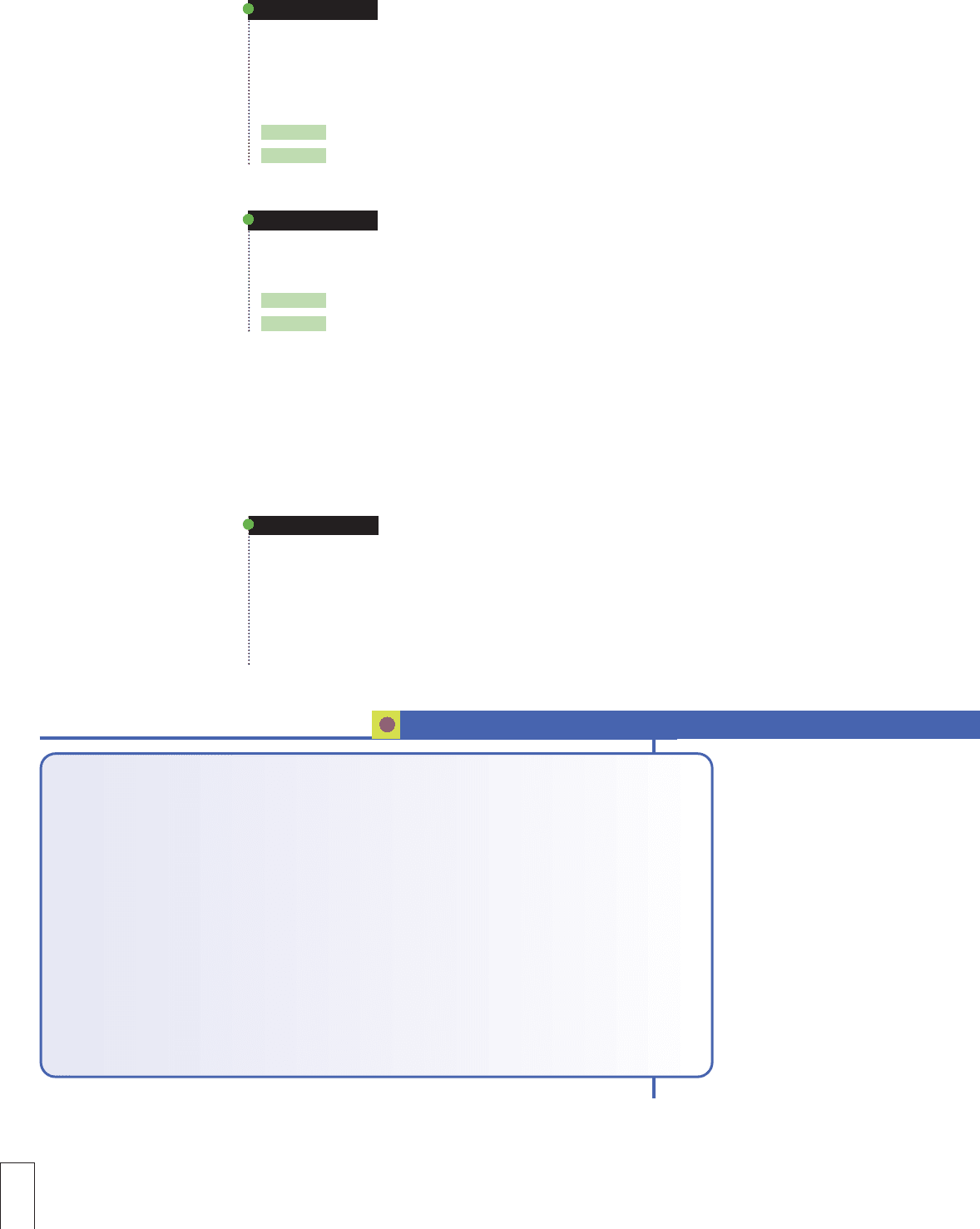
124 Part 2 Percentage Applications
EXAMPLE C
Eastern Restaurant Supply sells a set of mixing bowls with a list price of $200. Suzi’s
Muffins qualifies for the series of discounts: 25%, 20%, 10%. Compute the net price
using the discount method.
First Discount Second Discount Third Discount
0.25 3 $200 5 $50 0.20 3 $150 5 $30 0.10 3 $120 5 $12
$200 2 $50 5 $150 $150 2 $30 5 $120 $120 2 $12 5 $108
STEP 2
STEP 1
EXAMPLE D
Using the data in example C, calculate the net price using the complement method.
First Discount Second Discount Third Discount
100% 2 25% 5 75% 100% 2 20% 5 80% 100% 2 10% 5 90%
0.75 3 $200 5 $150 0.80 3 $150 5 $120 0.90 3 $120 5 $108
STEP 2
STEP 1
COMPLEMENT METHOD SHORTCUT
When using complement rates, the buyer may not need to know all of the intermediate
prices. If not, an efficient shortcut is to multiply the list price by all of the complement
rates successively.
EXAMPLE E
Repeat example D, using the shortcut. The list price is $200, and the discounts are 25%,
20%, and 10%. The complement rates are 75%, 80%, and 90%.
Net price 5 $200 3 0.75 3 0.80 3 0.90 5 $108
Note: Remember that there should be no rounding until you reach the final net price.
Then round it to the nearest cent.
a. A wholesaler offers a series of trade discounts: 30%, 25%, and 10%. Find each of the
discount amounts and the final net price on a $1,500 purchase.
First discount amount: $1,500 3 0.30 5 $450
Second discount amount: $1,500 2 $450 5 $1,050; $1,050 3 0.25 5 $262.50
Third discount amount: $1,050 2 $262.50 5 $787.50; $787.50 3 0.10 5 $78.75
Net price: $787.50 2 $78.75 5 $708.75
b. A series of trade discounts is 30%, 25%, and 10%. Find each of the complement rates, and
use the shortcut to calculate the final net price on a purchase of $1,500.
First complement rate: 100% 2 30% 5 70%
Second complement rate: 100% 2 25% 5 75%
Third complement rate: 100% 2 10% 5 90%
Net price: $1,500 3 0.70 3 0.75 3 0.90 5 $708.75
✔
CONCEPT CHECK 7.2
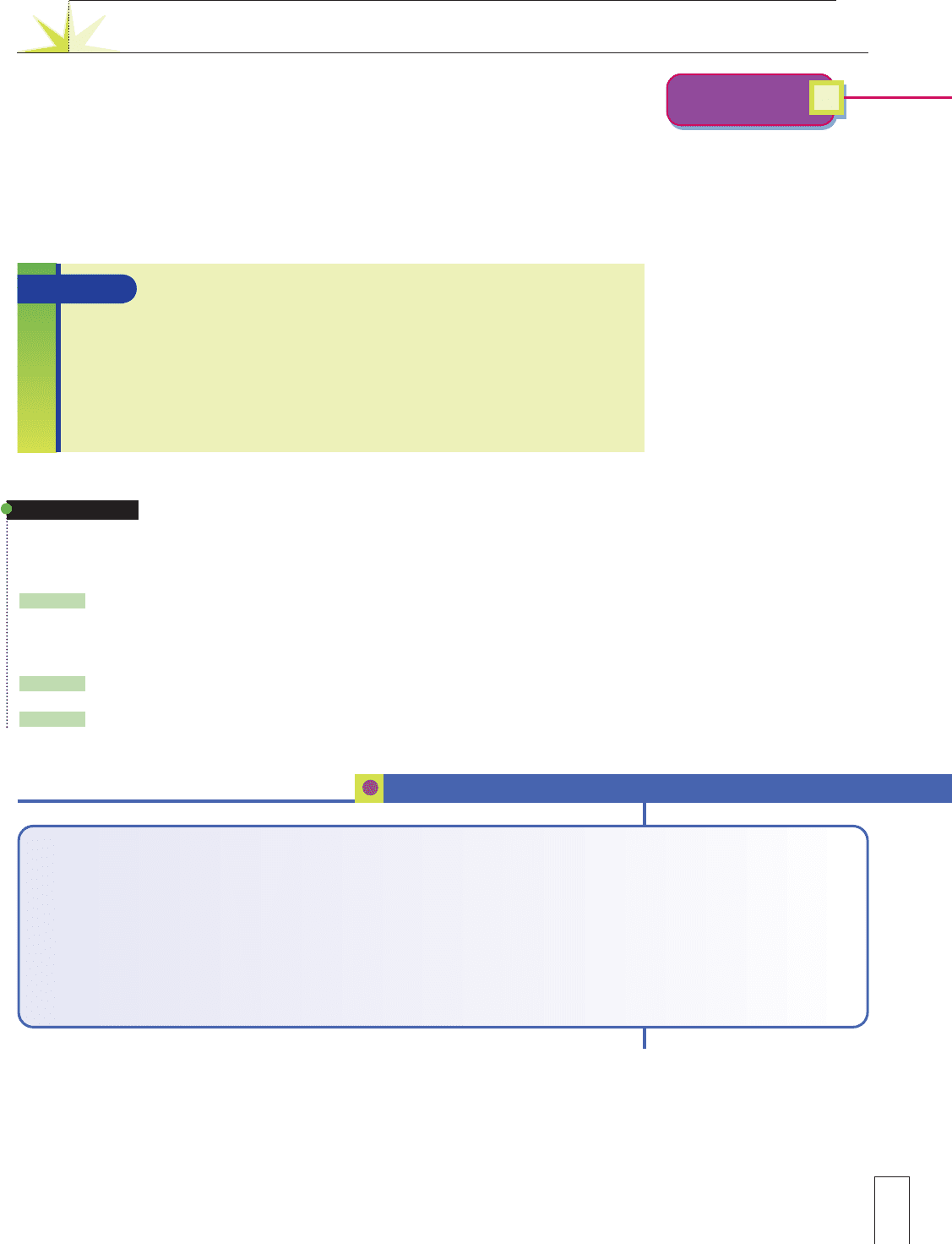
Suppose that an Eastern competitor, United Food Services, offers a single discount of
45% to Suzi’s Muffins. How does that rate compare to the series of discounts from
Eastern, 25%, 20%, and 10%? Suzi or her accountant could check by calculating the
equivalent single discount rate, which is the single discount rate that can be used in
place of two or more trade discount rates to determine the same discount amount.
The most efficient way to find the single discount rate that is equivalent to a series of
discounts is similar to the shortcut used in example E.
Chapter 7 Discounts 125
Compute the equivalent single
discount rate for a series of trade
discounts.
3
Learning Objective
Computing the Equivalent Single Discount Rate
7.3 Point out that the series of
discounts in example F is just slightly
better than the single discount of 45%.
If the series were 25%,20%,and 5%,
the single discount would be better.
to Compute the Equivalent Single Discount Rate
1. Compute the complement of each rate.
2. Multiply all the complement rates (as decimals), and then write the prod-
uct as a percent.
3. Subtract the product (Step 2) from 100% to get the equivalent single dis-
count rate.
STEPS
EXAMPLE F
Find the equivalent single discount rate for Eastern’s series of discounts: 25%, 20%,
and 10%.
First complement rate 5 100% 2 25% 5 75%
Second complement rate 5 100% 2 20% 5 80%
Third complement rate 5 100% 2 10% 5 90%
Product of complements 5 0.75 3 0.80 3 0.90 5 54%
Equivalent single discount 5 100% 2 54% 5 46%
STEP 3
STEP 2
STEP 1
A series of trade discounts is 50%, 30%, and 10%. Find the three complement rates and then find the equivalent single
trade discount rate.
Complement rates: 100% 2 50% 5 50%, 100% 2 30% 5 70%, 100% 2 10% 5 90%
Product of the complement rates: 0.50 3 0.70 3 0.90 5 0.315, or 31.5%
Equivalent single discount rate: 100% 2 31.5% 5 68.5%
COMPLETE ASSIGNMENT 7.1.
✔
CONCEPT CHECK 7.3
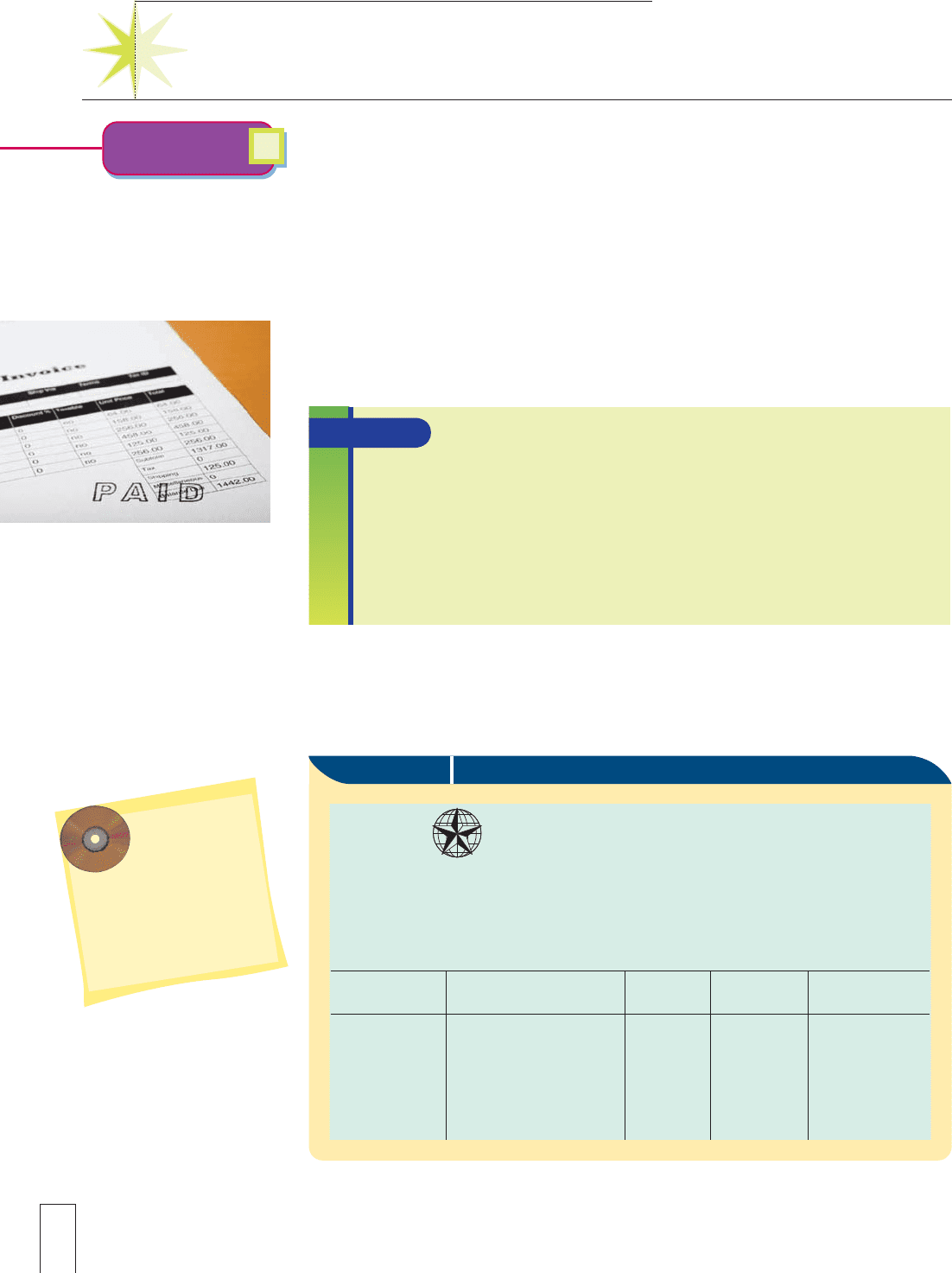
When a seller sends merchandise to a buyer, the seller usually wants to receive its pay-
ment quickly, and some buyers often try to delay payment as long as possible. Sellers can
encourage early payment by offering a cash discount; they can discourage late payment
by assessing an extra interest payment; or they can do both. These stipulations are called
the terms of payment, or simply the terms. The terms describe details about cash dis-
counts and/or penalty periods.
After shipping merchandise to a buyer, the seller usually sends a document called an
invoice, requesting payment. An invoice lists each item, its cost (including packaging and
freight), and the total cost. The invoice also states the terms of payment. The amount the
buyer pays is called the remittance. The net purchase amount is the price of the mer-
chandise actually purchased, including allowances for returns and excluding handling
and other costs.
126 Part 2 Percentage Applications
Computing Cash Discounts for
Fully Paid Invoices
4
Learning Objective
Compute cash discounts and
remittance amounts for fully paid
invoices.
7.4 For large purchases,the amount of
the cash discount may be large enough
that the buyer will consider borrowing
money for a few days just to get the
discount.(See Chapter 15.)
7.5 The term net purchase amount isn’t
really needed here,but it will be useful
when returned merchandise and/or
freight charges are considered later in
the chapter.
Cash Discounts
Video
to Compute the Remittance
1. Multiply the discount rate by the net purchase amount to get the cash
discount:
Cash discount 5 Discount rate 3 Net purchase amount
2. Subtract the cash discount from the net purchase amount to get the
remittance:
Remittance 5 Net purchase amount 2 Cash discount
STEPS
Figure 7-1 Sales Invoice
NATIONAL AUTOMOTIVE
SUPPLY
QUANTITY DESCRIPTION
UNIT
PRICE
GROSS
AMOUNT
NET
AMOUNT
May 23, 20––
2/10, n/30
UPS
Broadway Motors
730 W. Columbia Dr.
Peoria, IL 62170-1184
INVOICE NO. 782535
DATE
TERMS
SHIP VIA
SOLD TO
24 gals. Car wax $22.00 $528.00 $528.00
Figure 7-1 shows an invoice from National Automotive Supply, which sold car wax to
Broadway Motors for $528. The wax will be shipped via UPS, and National will pay for
the shipping. The invoice lists terms of 2/10, n/30. The invoice date, or the beginning of
the discount period, is May 23.
© ERICSPHOTOGRAPHY/ISTOCK-
PHOTO INTERNATIONAL
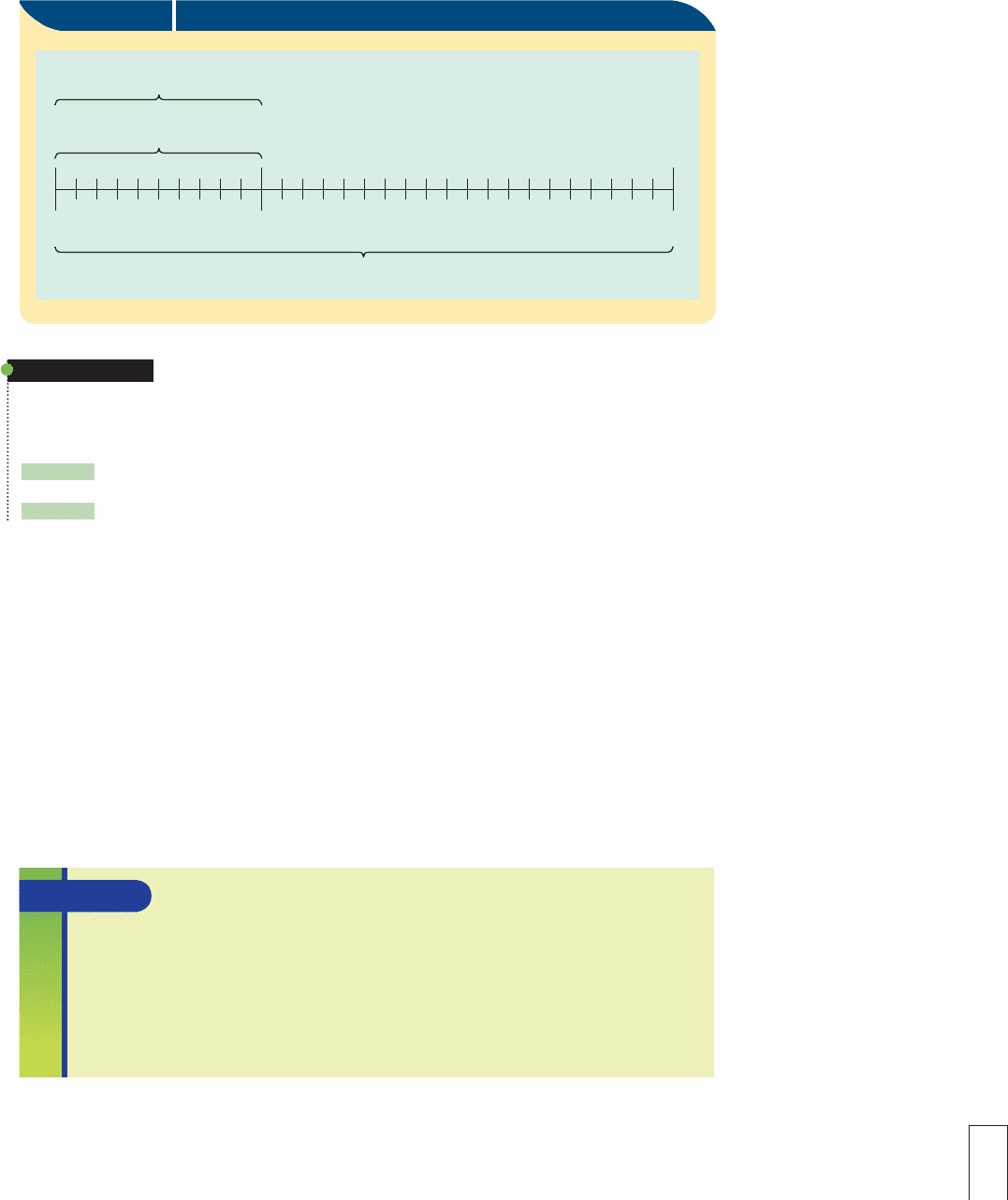
The expression 2/10, n/30 means that Broadway Motors can get a 2% discount if it
pays the full invoice within 10 days of the invoice date. Ten days after May 23 is June 2,
which is called the discount date. The 10-day period between May 23 and June 2 is
called the discount period. The n/30 is short for net 30, which means that if Broadway
Motors does not pay within 30 days, National will charge an interest penalty. Thirty days
after May 23 is June 22, which is called the due date. (See Figure 7-2.)
Chapter 7 Discounts 127
Figure 7-2 Cash Discount Time Line
Discount Period
10 Days
May 23 June 2
30 days
June 22
Due DateInvoice
Date
Discount
Date
EXAMPLE G
Compute the remittance due if Broadway Motors pays National for the $528 invoice
amount within the 10-day discount period under the terms 2/10, n/30.
Cash discount 5 2% of $528 5 0.02 3 $528 5 $10.56
Remittance 5 $528 2 $10.56 5 $517.44
STEP 2
STEP 1
All companies do not use exactly the same notation for writing their terms; 2/10,
n/30 is also written as 2/10, net 30 or as 2-10, n-30. Likewise, there can be more than one
discount rate and discount period. For example 2/5, 1/15, n/30 means that the seller gets
a 2% discount by paying within 5 days, gets a 1% discount by paying within 6 and 15 days,
and must pay a penalty after 30 days. To teach different notations, this book will present
cash discounts in various ways.
RETURNED MERCHANDISE AND FREIGHT CHARGES
The seller gives a discount only on merchandise that is actually purchased—the net pur-
chases. For example, there is no discount on returned items. Likewise, there is no dis-
count on charges from a third party, such as freight.
to Compute the Remittance When There Are Merchandise
Returns and/or Freight Charges
1. Net purchase 5 Invoice amount 2 Merchandise returns 2 Freight
2. Cash discount 5 Discount rate 3 Net purchase
3. Cost of merchandise 5 Net purchase 2 Cash discount
4. Remittance 5 Cost of merchandise 1 Freight, if any
STEPS

128 Part 2 Percentage Applications
EXAMPLE H
National Automotive Supply sells merchandise to Broadway Motors. The invoice amount
is $510, which includes $30 in freight charges. The invoice date is August 13, and the
terms are 2/10, n/30. Broadway Motors returns $200 worth of merchandise and pays the
rest of the invoice before the discount date. Compute the cash discount and the remit-
tance. Also, determine the discount date and due date.
Net purchase 5 $510 2 $200 2 $30 5 $280
Cash discount 5 0.02 3 $280 5 $5.60
Cost of merchandise 5 $280 2 $5.60 5 $274.40
Remittance 5 $274.40 1 $30 5 $304.40
Discount date 5 August 13 1 10 days 5 August 23
Due date 5 August 13 1 30 days 5 September 12
STEP 4
STEP 3
STEP 2
STEP 1
If you do not need to know the actual cost of the merchandise, you can eliminate
Step 3 and calculate the remittance directly:
Remittance 5 $280.00 2 $5.60 1 $30.00 5 $304.40
There is also a complement method for cash discounts. However, it is not used
universally because some businesses want to know the amount of the cash discount
before deciding whether to pay the invoice early. In the complement method for cash
discounts, only Steps 2 and 3 change.
to Compute the Remittance with the Complement Method
1. Net purchase 5 Invoice amount 2 Merchandise returns 2 Freight
2. Complement rate 5 100% 2 Cash discount rate
3. Cost of merchandise 5 Net purchase 3 Complement rate
4. Remittance 5 Cost of merchandise 1 Freight, if any
STEPS
EXAMPLE I
Solve example H by using the complement method for cash discounts. The invoice
amount is $510, merchandise returns are $200, and freight is $30.
Net purchase 5 $510 2 $200 2 $30 5 $280
Complement rate 5 100% 2 2% 5 98%
Cost of merchandise 5 0.98 3 $280 5 $274.40
Remittance 5 $274.40 1 $30 5 $304.40
STEP 4
STEP 3
STEP 2
STEP 1
7.6 As with trade discounts,the
method to be used depends on the
information wanted.With computers
and calculators, time and accuracy are
no longer considerations.
© MANCHAN/DIGITALVISION/GETTY IMAGES
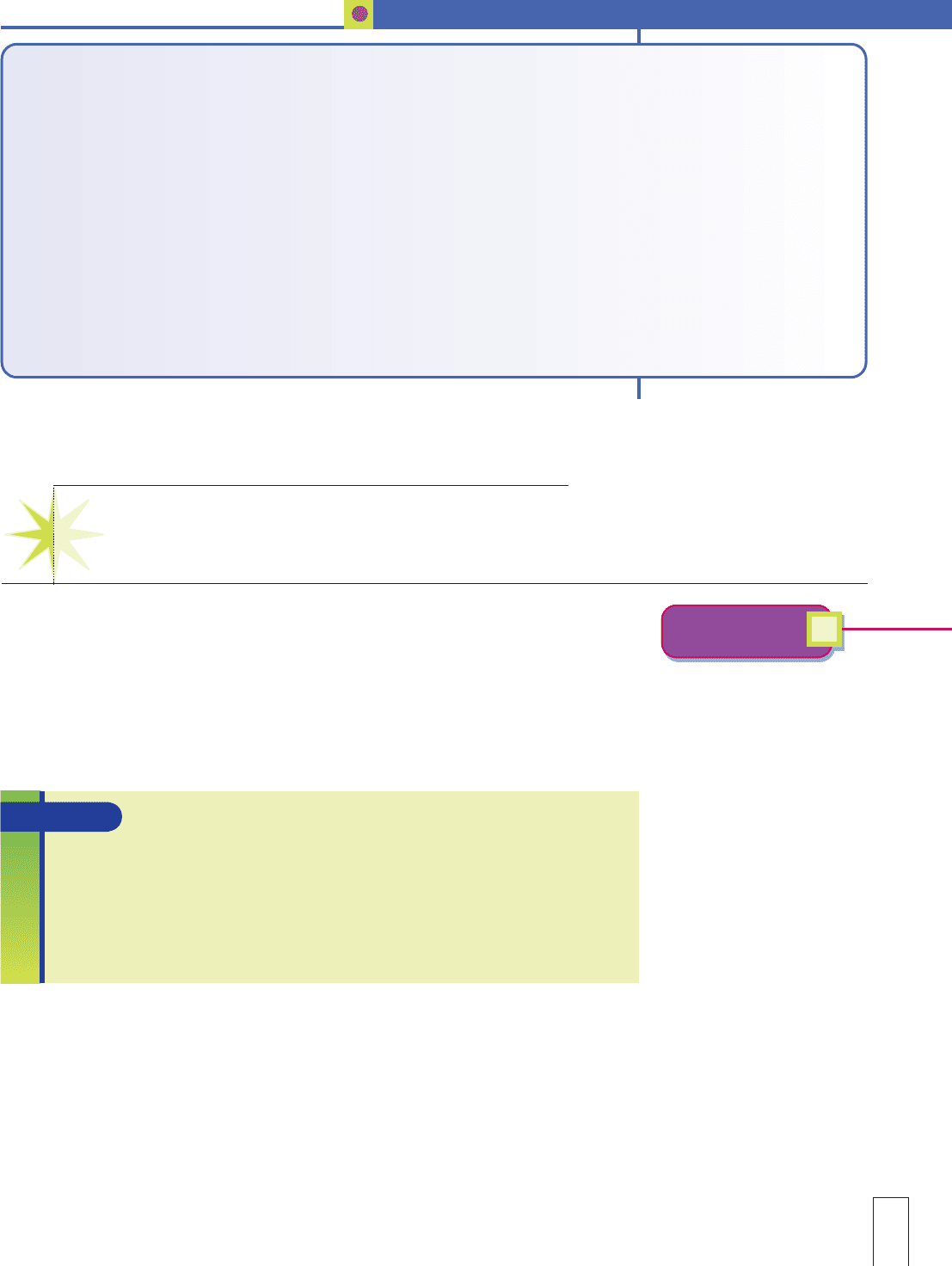
Sometimes a buyer would like to take advantage of a cash discount but can afford to pay
only part of the invoice within the discount period. If the seller allows discounts for par-
tial payment, the invoice will be reduced by the amount paid (remittance) plus the
amount of the discount. The total of the amount paid plus the amount of cash discount
is called the amount credited to the buyer’s account. To compute the amount credited,
you need to know the complement rate: 100% 2 Discount rate.
Chapter 7 Discounts 129
a. Use the given information to calculate the discount date, due date, cash discount, and remittance.
Terms: 1/10, n/60 Discount date 5 August 24 1 10 days 5 September 3
Invoice date: August 24 Due date 5 August 24 1 60 days 5 October 23
Invoice amount: $852.43 Net purchases 5 $852.43 2 $187.23 2 $47.20 5 $618.00
Returned goods: $187.23 Cash discount 5 0.01 3 $618 5 $6.18
Freight: $47.20 Remittance 5 $618 2 $6.18 1 $47.20 5 $659.02
b. Calculate the remittance for the problem in part (a), using the complement method.
Net purchases 5 $852.43 2 $187.23 2 $47.20 5 $618.00
Complement rate 5 100% 2 1% 5 99%
Cost of merchandise 5 0.99 3 $618 5 $611.82
Remittance 5 $611.82 1 $47.20 5 $659.02
✔
CONCEPT CHECK 7.4
Computing Cash Discounts for
Partially Paid Invoices
Compute cash discounts and
remittance amounts for partially
paid invoices.
5
Learning Objective
to Compute the Unpaid Balance
1. Compute the complement of the discount rate (100% 2 Discount rate).
2. Compute the amount credited by dividing the dollar amount paid
(remittance) by the complement rate.
3. Compute the unpaid balance by subtracting the amount credited
(Step 2) from the invoice amount.
STEPS
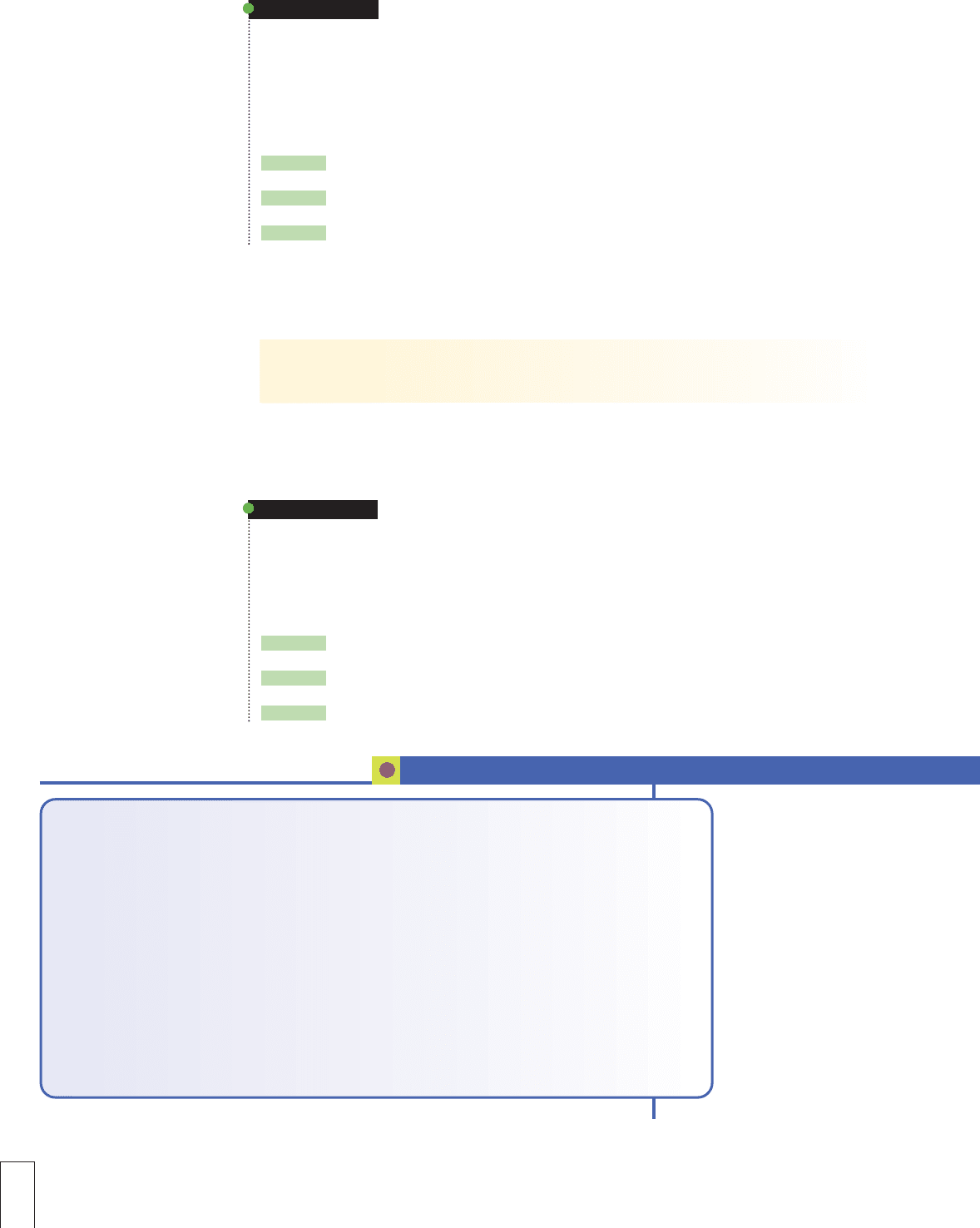
130 Part 2 Percentage Applications
EXAMPLE J
Larry Eickworth operates a shop called Space Savers, a do-it-yourself center for closet
and storage materials. Larry buys shelving supplies with an invoice price of $484 and
terms of 2/10, net 60. Within the 10-day discount period, he sends in a check for $300.
With a discount for the partial payment, how much credit should Larry receive, and
what will be his new unpaid balance?
Complement rate 5 100% 2 2% 5 98%
Amount credited 5 $300 4 0.98 5 $306.1224, or $306.12
Unpaid balance 5 $484.00 2 $306.12 5 $177.88
STEP 3
STEP 2
STEP 1
Note that, in example J, Larry receives $1.00 credit for every $0.98 paid. In other
words, the $300 actually remitted is 98% of the total amount credited. We can check this
result with multiplication:
Cash discount 5 0.02 3 $306.12 5 $6.1224, or $6.12
Remittance 5 $306.12 2 $6.12 5 $300.00
A slightly different situation, which arises less frequently, is when a buyer decides in
advance the total amount that he or she wants to have credited to the account. This
problem is exactly like the original cash discount problems.
EXAMPLE K
Larry Eickworth buys $484 worth of shelving materials for use in his closet and storage
shop. The terms are 2/10, net 60. Larry wants to pay enough within the 10-day discount
period to reduce his unpaid balance by exactly $300. What amount should he remit to
the seller? What will be his new unpaid balance?
Cash discount 5 2% 3 $300 5 $6
Remittance 5 $300 2 $6 5 $294
Unpaid balance 5 $484 2 $300 5 $184
STEP 3
STEP 2
STEP 1
a. An invoice for $476 has terms of 1/15, net 25. How much is the unpaid balance after a
$350 remittance is made within the discount period?
Complement rate 5 100% 2 1% 5 99%
Amount credited 5 $350 4 0.99 5 $353.54
Unpaid balance 5 $476.00 2 $353.54 5 $122.46
b. An invoice for $476 has terms of 1/15, net 25. What size remittance should be made in
order to have a total of $350 credited to the account?
Cash discount 5 $350 3 0.01 5 $3.50
Remittance 5 $350.00 2 $3.50 5 $346.50
COMPLETE ASSIGNMENT 7.2.
✔
CONCEPT CHECK 7.5
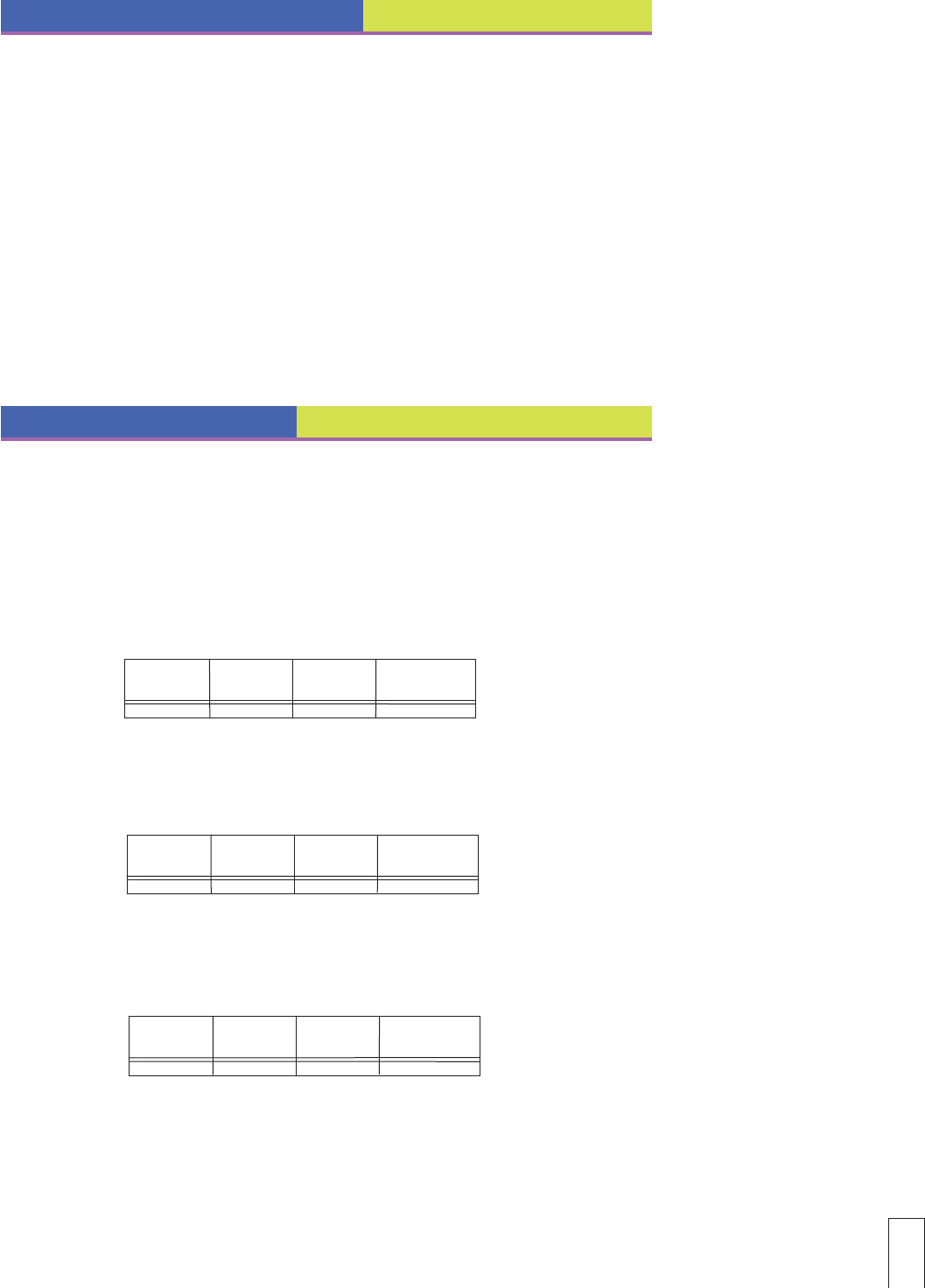
Chapter 7 Discounts 131
amount credited
cash discount
complement method
complement rate
discount date
discount method
discount period
discount rate
due date
equivalent single discount rate
invoice
invoice date
list price
net price
net purchase amount
remittance
series of discounts
terms of payment
trade discounts
Chapter Terms for Review
Try Microsoft
®
Excel
Try working the problems using the Microsoft Excel templates found on your student CD.
Solutions for the problems are also shown on the CD.
1. Find the required remittance for goods with a list price of $240, a trade discount of
25%, and a cash discount of 5%.
The formula is List Price 3 (1 2 Trade Discount %) 3 (1 2 Cash Discount %) 5
Remittance. Enter the values in the columns as labeled, and enter the formula in the Remit-
tance cell. Format the Remittance cell for Currency with two digits after the decimal point.
List Trade Cash
Price Discount Discount Remittance
2. What is the net price for goods with a list price of $2,200, a trade discount of 40%,
and another trade discount of 25%?
List Trade Trade
Price Discount Discount Net Price
3. What is the net price for goods with a list price of $1,650, a trade discount of 30%,
and another trade discount of 20%?
List Trade Trade
Price Discount Discount Net Price
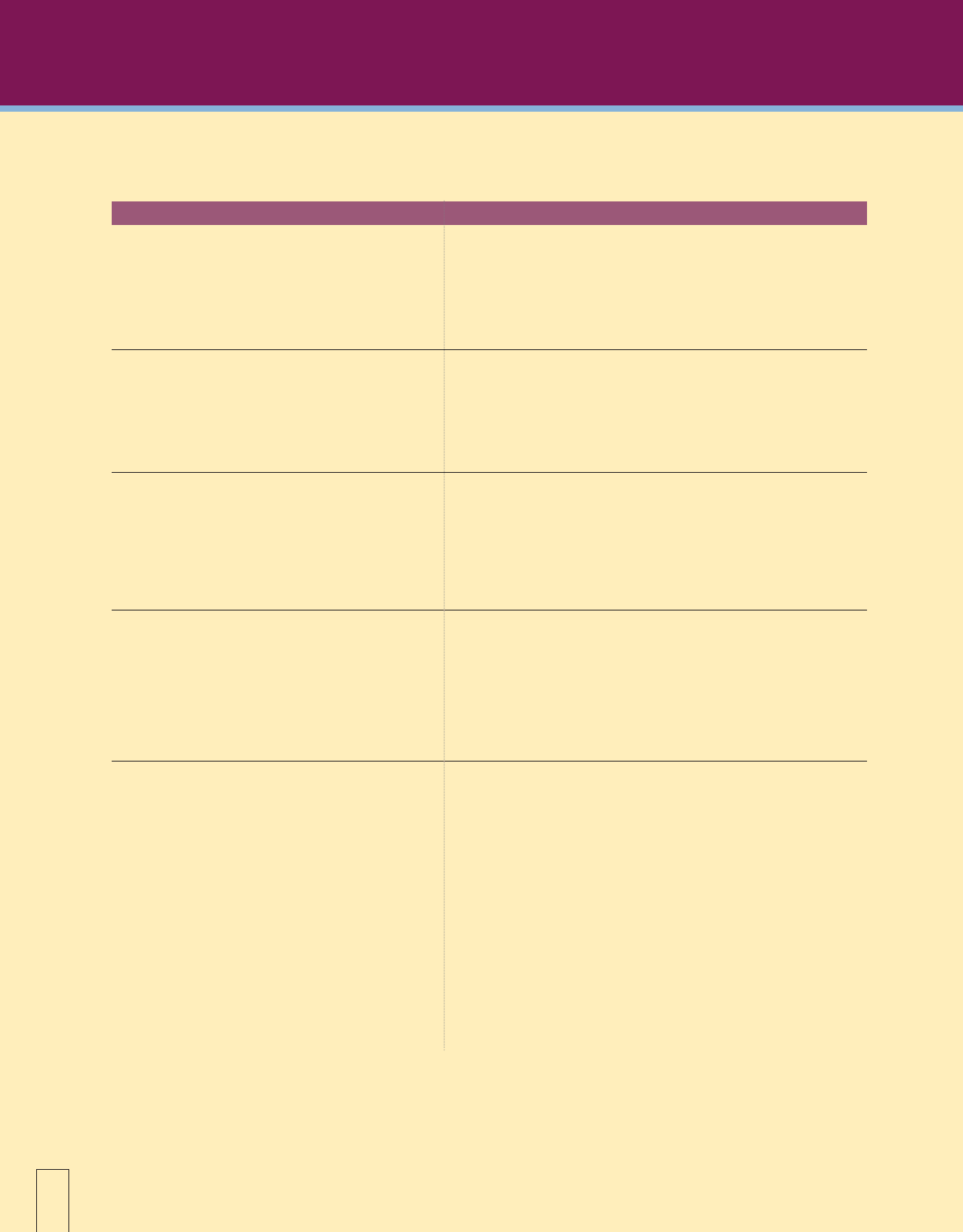
132 Part 2 Percentage Applications
THE BOTTOM LINE
Summary of chapter learning objectives:
Learning Objective
7.1
Compute trade discounts.
Answers: 1. Discount method: $280 2 $70 5 $210; complement method: 0.75 3 $280 5 $210
2. Discount method: $800 2 $200 5 $600, $600 2 $60 5 $540; complement method: 0.75 3 0.90 3 $800 5 $540
3. 49% 4. Discount date: June 5; due date: June 20; cash discount: $13.02; remittance: $705.30 5. $705.30
6. $87.63 7. $388.00
Example
1. Find the net price on a list price of $280 with a 25% trade discount,
using the discount and the complement methods.
7.2
Compute a series of trade discounts.
7.3
Compute the equivalent single discount rate for a series
of trade discounts.
7.4
Compute cash discounts and remittance amounts for
fully paid invoices.
7.5
Compute cash discounts and remittance amounts for
partially paid invoices.
2. Find the net price on a list price of $800 with a series of trade
discounts of 25% and 10%. Use both the discount method and the
complement method.
3. A series of trade discounts is 25%, 20%, 15%. Use complement rates
to find the equivalent single discount rate.
An invoice is dated May 26 and has terms of 2/10, n/25. The total in-
voice is $826.44, with $108.12 of returned goods and $67.37 freight.
4. Compute the discount date, due date, cash discount, and remittance.
5. Compute the remittance using the complement rate.
An invoice for $500 has terms of 3/5, net 45.
6. Compute the unpaid balance after a $400 payment within the
discount period.
7. Compute the remittance required within the discount period in order
to have $400 credited to the account.

Chapter 7 Discounts 133
SELF-CHECK
Review Problems for Chapter 7
In problems 1 and 2, use the discount method to
compute the missing terms.
1 List price, $760; trade discount, 25%
a. Discount amount
b. Net price
2 List price, $1,200; trade discounts, 30%
and 20%
a. First discount amount
b. Second discount amount
c. Net price
In problems 3 and 4, use the complement method to
compute the missing terms.
3 List price, $875; trade discount, 40%
a. Complement rate
b. Net price
4 List price, $1,800; trade discounts, 30%
and 15%
a. First complement rate
b. Second complement rate
c. Net price
5 Patty Duncan is a broker of hotel rooms in Europe. To tour directors, she offers a standard trade discount of
40% off the list price. She has additional discounts of 20% and 10%, which are based on the number of tours
in a season and the total number of tourists. Compute the equivalent single discount rate for a major tour or-
ganizer, Kristi Atchison, who qualifies for all three discounts.
a. First complement rate c. Third complement rate
b. Second complement rate d. Equivalent single discount rate
Use the invoice information given in problems 6 and 7 to compute the missing terms.
6 Terms: 2/10, n/30
Invoice Date: July 25
Invoice Amount: $874.55
Freight: 0
Returned Goods: 0
a. Discount date
b. Due date
c. Discount amount
d. Remittance
7 Terms: 3/5, net 45
Invoice Date: December 28
Invoice Amount: $2,480
Freight: $143
Returned Goods: $642
a. Discount date
b. Due date
c. Complement rate
d. Remittance
8 Joyce Thompson purchased some new pieces of office furniture for her Internet consulting firm. The invoice
amount was $16,540 with terms of 2/10, net 60 and the discount would apply to any partial payment made
within the discount period. Joyce sent in a check for $10,000 by the discount date. Find: (a) the amount
credited to Joyce’s account
;
and (b) the unpaid balance .
Answers to the Self-Check can be found in Appendix B at the back of the text.
